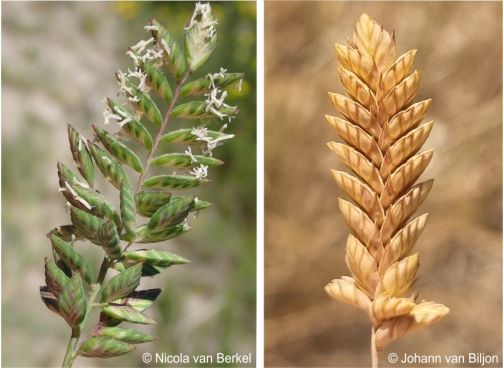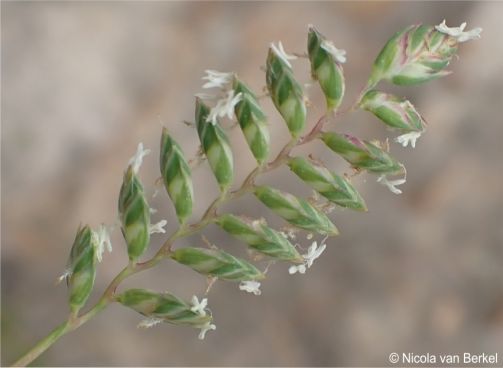Tribolium uniolae
Tribolium uniolae (L.f.) Renvoize
Family: Poaceae
Common names: hare grass (Eng.); haasgras, koringgras (Afr.)
Introduction
A small, tufted, perennial grass with attractive inflorescences that are used in flower arranging.

Description
Description
Tribolium uniolae is a tufted perennial 100-700 mm high, occasionally rhizomatous, stolons absent. Leaf blade 50-300 × 0.5-5.0 mm, rolled or expanded, sickle-shaped towards apex, stiff glabrous to hairy, hairs simple. Inflorescence terminal, 8-70 mm long, spike-like, linear, contracted, distichous or with a few basal branches, usually secund, partly enclosed or exserted from uppermost leaf, a dehiscence node absent below flag-leaf. Spikelet to 4-10 × up to 4 mm, florets 5-9, glumes shorter than spikelet, acute to acuminate, glabrous or sparsely hairy with tubercle-based hairs, lemma 4-6 mm long, obtuse to acute, glabrous or hairy, hairs club-shaped, awnless, palea acute, glabrous or hairy between keels, tufted of long marginal hairs Present or absent, anthers 1.6-3.1 mm long. It flowers in spring and early summer, from September to December.

Conservation Status
Status
Tribolium uniolae is currently assessed as Least Concern (LC) in the Red List of South African plants. This means that the species is not threatened and is not at a risk of becoming extinct. It is endemic to South Africa and was introduced in Australia, and has become a weed in both Victoria and Western Australia, where it grows on disturbed ground and flowers from October to December.
Distribution and habitat
Distribution description
This plant is found on well-drained soils derived from granite, sandstone, shales or limestone, in a number of vegetation types, from sea level to 1 000 m, in disturbed areas such as roadsides and fields, from the Bokkeveld Mountains in the Northern Cape, through the Western Cape to Gqeberha (formerly Port Elizabeth) in the Eastern Cape.

Derivation of name and historical aspects
History
The name Tribolium is derived from the Latin tri- or Greek treis, meaning ‘three’ and the Greek bolos, meaning ‘point’, thus ‘three pointed’, possibly referring to the three florets enclosed in the very bristly glumes. The species name uniolae means ‘resembling Uniola’ a genus of grasses in the Americas, commonly called sea oats. Carl Linnaeus, the younger, first described it as Cynosurus uniolae, but in 1985 it was transferred to the genus, Tribolium, by Stephen Andrew Renvoize.
The genus Tribolium has 14 species of which 8 occur in the Klein Karoo. This genus also includes Karroochloa. Other noteworthy members of this genus are Tribolium hispidum with its hairy spikelet bracts and Tribolium obliterum with its tiny club-shaped hairs on the floret bracts.

Ecology
Ecology
Locally common in southern Africa, it is found on well-drained soils derived from granite, shales, sandstones or limestones, occurring in a number of vegetation types, from sea level up to 1 000 m, in disturbed areas such as roadside and fields. It appears to be stimulated by fire and may be very common after scrub-fires. Small herbivores such as hares (haas in Afrikaans) feed on this grass, hence the common name.

Uses
Use
Most species of Tribolium are of little value as fodder but they are very useful for restoring disturbed sites, including unproductive ploughed areas in Renosterveld. The seeds of this plant are not commercially available. Therefore they are not available in nurseries but can be bought on the internet.

Growing Tribolium uniolae
Grow
Plants reproduce by forming small perennating buds that break off from the base, thus creating clones of itself. This species mainly reproduces by seeds, which should be sown in autumn in a well-drained medium. The survival rate of seedlings appears to be highest in wetter habitats such as beside rivers and streams and along drainage lines.
References
- AusGrass, Tribolium uniolae (L.f.) Renv. https://keys.lucidcentral.org/keys/v3/AusGrass/key/AusGrass/Media/Html/TRIBOLIU/TRIUNIO.HTML. Accessed 30/06/2023.
- AusGrass2 Grasses of Australia, Tribolium uniolae. https://ausgrass2.myspecies.info/content/tribolium-uniolae. Accessed 30/06/2023.
- Fish, L., Mashau, A.C., Moeaha, M.J. & Nembudani, M.T. 2015. Identification guide to southern African grasses. Strelitzia 36: 271–276. South African National Biodiversity Institute, Pretoria.
- Florabase, Tribolium uniolae (L.f.) Renvoize https://florabase.dbca.wa.gov.au/browse/profile/11112. Accessed 04/08/2023.
- Kesting, K. & Clarke, H. 2014. Botanical names: what they mean. Wild flowers of the Cape Peninsula. Ed. 3, 2nd reprint. Flora Documentation Programme, Muizenberg.
- Manning, J. & Goldblatt, P. 2012. Plants of the Greater Cape Floristic Region 1: the Core Cape Flora. Strelitzia 29. South African National Biodiversity Institute, Pretoria.
- Raimondo, D., Von Staden, L., Foden, W., Victor, J.E., Helme, N.A., Turner, R.C., Kamundi, D.A. & Manyama, P.A. (eds) 2009. Red list of South African plants. Strelitzia 25. South African National Biodiversity Institute, Pretoria.
- Smith, C.A. 1966. Common names of South African plants. Memoirs of the Botanical Survey of South Africa No. 35. Government Printer, Pretoria.
- Van Berkel, N. 2012-11-23. Observation of Tribolium uniolae, Robberg Corridor, Western Cape. iNaturalist. Online. https://www.inaturalist.org/observations/10831143.
- Van Berkel, N. 2018-11-9. Observation of Tribolium uniolae, Kranshoek, Western Cape. iNaturalist. Online. https://www.inaturalist.org/observations/18894392.
- Van Berkel, N. 2022-10-28. Observation of Tribolium uniolae, Prince Alfred’s Pass, Western Cape. iNaturalist. Online. https://www.inaturalist.org/observations/141459714
- Van Biljon, J. 2022. Observations of Tribolium uniolae, Western Cape. iNaturalist. Online. https://www.inaturalist.org/observations/142282107 & https://www.inaturalist.org/observations/136785497.
- Vlok, J. & Schutte-Vlok, A-L. 2015. Plants of the Klein Karoo. Umdaus Press, Hatfield.
- Wikipedia, Tribolium uniolae. https://en.wikipedia.org/wiki/Tribolium_uniolae. Accessed 04/08/2023.
- Wikipedia, Uniola. https://en.wikipedia.org/wiki/Uniola. Accessed 10/08/23.
Credits
Laura Dineo Selepe
Karoo Desert National Botanical Garden
August 2023
Acknowledgements: the author thanks Nicola van Berkel and Johann van Biljon for making their images available on iNaturalist.
Plant Attributes:
Plant Type: Grass
SA Distribution: Eastern Cape, Northern Cape, Western Cape
Soil type: Sandy, Clay, Loam
Flowering season: Spring, Early Summer
PH: Acid, Neutral
Flower colour: Green, Cream
Aspect: Full Sun
Gardening skill: Average
Special Features:
Horticultural zones








Rate this article
Article well written and informative
Rate this plant
Is this an interesting plant?
Login to add your Comment
Back to topNot registered yet? Click here to register.